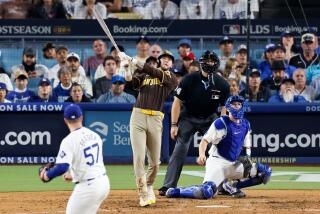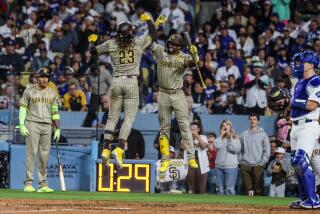Grass Always Looks Greener Now on the Padres Home Turf
- Share via
SAN DIEGO — Brian Bossard’s handiwork is tested 324,000 times a year in front of thousands of people. If it doesn’t measure up one of those times, well, Bossard figures he’s still doing pretty well.
After all, one mistake in 324,000 chances isn’t bad. “Even cars and planes fail more often than that,” Bossard said.
Bossard is the field manager at San Diego Jack Murphy Stadium. He’s responsible for the two acres of grass and dirt surrounded by the stadium’s 59,000 seats.
Bossard has calculated that about 4,000 ground balls cross the infield every time the Padres play at home (counting batting and infield practice as well as the game). Since half of the team’s 162 games are played at home, that works out to roughly 324,000 grounders a season.
No matter how careful he has been, Bossard says, sooner or later one of those balls is going to take a bad bounce. And unfortunately for him, that’s the one everyone will remember. Bossard will take the heat from managers and players, perhaps his own boss and even the fans.
So being a field manager is a tough job, high on pressure and low on thanks. But is it interesting? Is it really all that important?
Yes and yes.
Secret Weapon
Bossard does more than push dirt around with a rake--he’s a scientist and an artist whose medium is a layered surface of baked clay. Now that the baseball season is under way, he’s a kind of secret weapon for the team. “If you do the job right, you should be able to change the outcome of maybe eight or nine games a year,” said Bossard.
The word groundskeeper brings to mind an image of some elderly, potbellied fellow with a cigar clamped between his teeth, pushing around a wheelbarrow. Bossard doesn’t fit the stereotype. A wiry, intense man who admits only to being “right around 31” years of age, he has a bachelor’s degree in agronomy (translation: soil management) from Purdue University.
He didn’t learn to take care of a baseball field at college. “I learned around the dinner and breakfast table and on the field,” said Bossard, whose father, Harold Bossard, was a groundskeeper for the Cleveland Indians for 43 years.
“I was 11 when I started working after school as my dad’s assistant. I’d help out on the field all summer, too. I learned not only the things to do and not to do, but the reasons behind them,” Bossard said.
Runs in the Family
The Bossard family is to groundskeeping what the Ford family is to cars. Bossard’s grandfather was also a groundskeeper who pioneered some of the techniques now routinely used to care for athletic fields. In addition, Bossard has two uncles who are in the business; one tends the home field of the Cleveland Indians and the other looks after Comiskey Park in Chicago, home of the Chicago White Sox.
When his father retired in 1977, Bossard took over as field manager for the Cleveland Browns football team. In 1985, the San Diego Stadium Authority hired him to revamp the local baseball field, which had a reputation as one of the worst in the major leagues.
Almost as soon as he arrived in San Diego, Bossard was given a folder that contained 136 newspaper articles, all of them about how bad the field was.
“The infield was inconsistent,” said Steve Garvey, the Padres’ first baseman. Sometimes balls bounced high, other times they simply skidded across the dirt. “And it deteriorated throughout the season,” Garvey added.
‘He’s the Best’
“It was like a minor-league field,” agreed Garry Templeton, the Padres’ shortstop. “I don’t think the city took much pride in it.
“But the field is like a baby to Brian. He’s the best. That infield is (now) the best infield in the National League--by far.”
Over the last three years, Bossard has essentially directed the reconstruction of the entire field. The grass was the easy part--it was dead when he arrived. He had parts of the outfield regraded to his satisfaction, then replanted the grass.
The infield required more attention. Bossard stripped away the old infield foundation--including a layer of rocks eight inches below the surface--and replaced it with three layers of baked clay. The deepest layer is the densest and has the highest tensile strength (resistance to being pulled apart), while the topmost layer is the most porous and has the lowest tensile strength, he explained.
“The whole thing is constructed so that we’re able to control how high a (typical) ball bounces. We want it to come up into an 18-inch area between your knees and your waist,” he said.
Atop the foundation, he and his crew spread a mixture of sand and finely screened baked clay.
“Out of a 50-pound bag of baked clay we wind up using only 30 pounds, but virtually all the particles that fall through the screen are the same size, and won’t compact” into hard spots, Bossard noted.
Tailored for Players
In addition, he tailors certain areas according to players’ desires. Templeton, for example, prefers to stand on hard ground but wants the infield area in front of him a little softer, so that hard-hit balls will bounce lower.
“I talk to (Bossard) every day. If there’s something wrong with the field, he’ll come and tell me about it before I even go out there,” Templeton said.
“He hates to see the ball take a bad hop on anybody. I remember one time last year I missed a grounder, and when the inning was over he came running up to me, saying, ‘Was it the field? Was it the field?’ ”
On that occasion, Templeton had simply played the ball wrong, and said so to Bossard. “But if the ball does take a bad hop, he’ll be out there all day the next day fixing the problem,” Templeton added.
Bossard, who played shortstop in high school, often has one of his crew members hit him grounders so that he can learn firsthand how the field plays. And right before the start of each game, he patrols the infield with his eyes glued to the ground.
“I’m looking for two things,” he said. “One is chipping caused by cleats. That tells me which spots have too much water and which don’t have enough,” a problem that can be remedied by watering the following day.
“I’m also looking for little rocks that have somehow gotten onto the field,” Bossard continued. “And a new problem is that a lot of ballplayers these days chew sunflower seeds and spit the shells out on the field. Those can cause bad hops, too.
‘Very Picky’
“If I see the smallest little thing, I tell my crew to pick it up. I’m very, very picky.”
If he has missed something, he’ll hear about it. When a ball seemed to take a weird bounce at one of the Dodger players last year, Dodger manager Tommy Lasorda yelled over to Bossard, who was sitting in the Padres’ dugout, “What the . . . was that?”
St. Louis Cardinals shortstop Ozzie Smith tossed a baseball toward Bossard last year after Smith fell down three times in one game trying to steal bases. But Bossard just laughed at that--he knew he deserved it.
Bossard had deliberately created a soft, mushy area near first base, right where Smith took his lead when he planned on stealing second. The Padres’ players knew about the soft spot and avoided it. But Smith didn’t, and when he took off for second, he wound up sprawled on his belly. The third time it happened, he went back to the Cardinals’ dugout, got a baseball and hurled it across the diamond in Bossard’s direction.
Such subtle changes in landscaping are the means by which a field manager can influence the outcome of a game, Bossard explained. Foul lines that are graded slightly inward can cause slow ground balls to stay in fair territory, for example, potentially resulting in an extra man on base or even the winning run. And a steep slope on the front of the pitcher’s mound will enable a pitcher to get a little extra velocity on the ball, according to Bossard.
Gives Padres Edge
Such things could conceivably help not only the Padres but their opponents, of course. But Bossard consults with and informs the Padres about any changes he makes on the field; he wouldn’t dream of telling the opposing team about them. “It gives the Padres an edge,” he said.
Bossard hasn’t yet talked to rookie manager Larry Bowa about how to tailor the field for this year’s Padre squad, but one likely difference in the field this season will be a softer home-plate area.
Previous Padre managers wanted the area around home plate hard, because former catcher Terry Kennedy often hit balls that bounced near the plate. The harder the ground, the higher the balls would bounce, giving the lumbering Kennedy a better chance of reaching first base safely. But Kennedy was traded to the Baltimore Orioles last fall, and Bowa indicated recently that he wants to tailor the field around pitching and defense.
Bossard, who is in charge of a full-time crew of eight and an additional part-time crew of six that works during night games, also readies the field for the Chargers and for special events such as rock concerts and motocross races. Rock concerts are the hardest on the field, he said, because of the heavy equipment used to construct the stages and set up the band.
Nevertheless, the most challenging part of his job “is the baseball aspect of it,” he said. “You can get a zillion guys to take care of grass, but learning how to construct and maintain an infield, how to find out what a ball’s going to do, and how to make it do what you want it to--that’s the hardest part.”
More to Read
Are you a true-blue fan?
Get our Dodgers Dugout newsletter for insights, news and much more.
You may occasionally receive promotional content from the Los Angeles Times.










